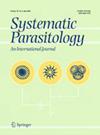墨西哥棘袋鼠(杂家鼠目:杂家鼠科)寄生的一新种记述(蜱螨亚纲:杂家鼠科)。
IF 1.2
4区 医学
Q4 PARASITOLOGY
引用次数: 0
摘要
本文描述了墨西哥棘袋鼠(Heteromys irroratus Gray)(啮齿目:棘袋鼠科)的雌性。该新种的雌性与美洲的Ixodes Latreille(1795)亚属的所有其他种的不同之处是:表皮上的侧隆和刺的发育、异皮刚毛的长度、耳廓的形状和大小、尾骨上的刺的发育和大小以及缺少共尾。本文章由计算机程序翻译,如有差异,请以英文原文为准。
Description of a new species of Ixodes Latreille, 1795 (Acari: Ixodidae), parasite of the Mexican spiny pocket mouse, Heteromys irroratus Gray (Rodentia: Heteromyidae) in Mexico.
Ixodes (Ixodes) zacateco n. sp. (Acari: Ixodidae) is described based on females ex the Mexican spiny pocket mouse, Heteromys irroratus Gray (Rodentia: Heteromyidae) from Mexico. Females of this new species are different from all other species of the subgenus Ixodes Latreille, 1795 from the Americas by the development of lateral carinae and punctations on scutum, length of alloscutal setae, shape and size of auriculae, development and size of spurs on coxae and lack of syncoxae.
求助全文
通过发布文献求助,成功后即可免费获取论文全文。
去求助
来源期刊

Systematic Parasitology
医学-寄生虫学
CiteScore
2.20
自引率
23.10%
发文量
64
审稿时长
6-12 weeks
期刊介绍:
Systematic Parasitology publishes papers on the systematics, taxonomy and nomenclature of the following groups: Nematoda (including plant-parasitic), Monogenea, Digenea, Cestoda, Acanthocephala, Aspidogastrea, Cestodaria, Arthropoda (parasitic copepods, hymenopterans, mites, ticks, etc.), Protozoa (parasitic groups), and parasitic genera in other groups, such as Mollusca, Turbelleria, etc. Systematic Parasitology publishes fully illustrated research papers, brief communications, and fully illustrated major revisions. In order to maintain high standards, all contributors describing new taxa are asked to state clearly where the holotype is deposited and to make paratypes available for examination by the referees. It is recognized that, in some cases, this may cause problems for the authors, but it is hoped that by adhering to this rule authors may be protected against rapid synonymy of their taxa, and the types will be preserved for posterity.
 求助内容:
求助内容: 应助结果提醒方式:
应助结果提醒方式:


